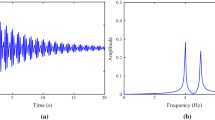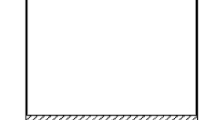Abstract
The online identification of the dynamic properties of large structures is an integral part of structural health monitoring. The success of any vibration-based condition monitoring system requires a computationally efficient identification procedure with the potential to be used online. Computational efficiency and automation are the two fundamental requirements of an effective identification procedure. In this study, we propose a solution of a Bayesian-based formulation for the online extraction of structural modal parameters using output-only data. The proposed algorithm uses a Bayesian maximum a posteriori (MAP) estimation; the objective function is defined as a posterior probabilistic density estimation of the dynamic parameters obtained from observations. The conditional probability distribution function (PDF) is computed using a Bayesian approach to minimum mean-square estimation. To reduce the computational costs, we propose to employ an adaptive filtering technique where expansion and truncation of the conditional PDF are implemented to consider the measurement time series as finite-order Markov processes. The methodology is validated through analyses of two documented examples. Comparison with traditional identification methods clearly shows the superiority of the proposed algorithm. The findings demonstrate that the Bayesian-based methodology provides reliable modal parameter identification in dynamic systems, even for data with high noise content.
Similar content being viewed by others
References
Beck JL, Katafygiotis LS (1998) Updating models and their uncertainties, I: Bayesian statistical framework. J Eng Mech 124(4):455–461
Chakraverty S (2005) Identification of structural parameters of multi-storey shear buildings from modal data. Earthq Eng Struct Dyn 34:543–554
Chase JG, Hwang KL et al (2005) A simple LMS-based approach to the structural health monitoring benchmark problem. Earthq Eng Struct Dyn 34:575–594
Ewins DJ (2000) Modal testing: theory, practice and application. Hertfordshire, England, Research Studies Press Ltd, Baldock
Ghrib F, Mamedov H (2004) Period formulas of shear wall buildings with flexible bases. Earthq Eng Struct Dyn 33:295–314
Huang CS (2001) Structural identification from ambient vibration measurement using the multivariate AR model. J Sound Vib 241(3):337–359
IASC-ASCE (2004) Structural Health Monitoring Task Group. http://wusceel.cive.wustl.edu/asce.shm/. Accessed 30 June 2011
Jaishi B, Ren WX (2005) Structural finite element model updating using ambient vibration test results. J Struct Eng 131(4):617–628
Juang JN (1994) Applied system identification. Prentice Hall, Englewood Cliff
Kelley CT (1999) Iterative Methods for Optimization. SIAM, Philadelphia
Li HN, Ren L, Jia ZG, Yi TH, Li DS (2016) State-of-the-art in structural health monitoring of large and complex civil infrastructures. J Civ Struct Health Monit 6(1):3–16
Ljung L (1999) System identification: theory for the user. Prentice Hall, New Jersey
Ljung L (2014) System identification toolbox-user’s guide. Mathworks Inc, Natick
Lutes LD, Sarkani S (2004) Random vibrations, analysis of structural and mechanical systems. Elsevier Butterworth-Heinemann, Oxford
Overschee PV, Moor BD (1997) Subspace identification for linear systems: theory—implementation—applications. Kluwer Katholieke Universiteit Leuven, Belgium
Pridham BA, Wilson JC (2004) Identification of base-excited structures using output-only parameter estimation. Earthq Eng Struct Dyn 33:135–155
Raineri C, Fabbrocino Cosenza (2007) Automatic operational modal analysis as structural health monitoring tool: theoretical and applications aspects. Key Eng Mater 347:479–484
Rao R, Pownuk A, Vandewalle S, Moens D (2010) Transient Response of structures with uncertain structural parameters. Struct Saf 32:449–460
Robert CP (2007) The Bayesian choice: from decision-theoretic foundations to computational implementation. Springer, Berlin
Rustagi JS (1994) Optimization techniques in statistics. Academic Press, Cambridge
Sayed AH (2003) Fundamentals of adaptive filtering. Wiley, New Jersey
Spencer B Jr (2004) Benchmark Structural Control Problems for Seismic- and Wind-Excited Structures. J Eng Mech 130(4):363–365
Tarantola A (2005) Inverse problem theory and methods for model parameter estimation. SIAM, Philadelphia
Vaseghi SV (2000) Advanced digital signal processing and noise reduction. Wiley, New Jersey
Yuen KV (2010) Recent developments of Bayesian model class selection and applications. Struct Saf 32:338–346
Yuen KV, Katafygiotis LS (2005) Model updating using noisy response measurements without knowledge of the input spectrum. Earthq Eng Struct Dyn 34:167–187
Zapico JL, Gonzalez MP et al (2003) Finite element model updating of a small scale bridge. J Sound Vib 268:993–1012
Zhang FL, Ni YC, Au SK, Lam HF (2016) Fast Bayesian approach for modal identification using free vibration data. Part I-most probable value. Mech Syst Signal Process 70:209–220
Author information
Authors and Affiliations
Corresponding author
Rights and permissions
About this article
Cite this article
Ghrib, F., Li, L. An adaptive filtering-based solution for the Bayesian modal identification formulation. J Civil Struct Health Monit 7, 1–13 (2017). https://doi.org/10.1007/s13349-016-0199-y
Received:
Revised:
Accepted:
Published:
Issue Date:
DOI: https://doi.org/10.1007/s13349-016-0199-y














